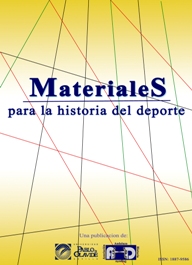The introduction of asian martial arts in Portugal
Keywords:
jujutsu, Japan, sporting Japonism, images, show.Abstract
The present study analyzes the introduction of jujutsu in Portugal at the beginning of the 20th century. Mainly, historical Portuguese newspapers were reviewed, both general and specific from sports field. Results show that the introduction of jujutsu in Portugal was principally conduced via the show business through exhibitions performed by Japanese experts. Significant technical and physical differences between the Japanese fighters and the professional Freestyle and Greco-roman fighters, who were usually defeated by the former, contributed to create a powerful imaginary of the eastern fighting arts as superior systems of physical culture and self-defence. However, in spite of jujutsu’s success, it did not come to be strongly established in Portugal, vanishing progressively off the public scene since the beginning of the 1910s.
Downloads
References
ARCHER, Jeff y SVINTH, Joseph (2001). “Wrestling, Proffessional”. En Thomas A. Green
(Ed.). Martial arts of the world: an encyclopedia. Vol. II. (pp. 735-743). Santa Barbara,
CA: ABC-CLIO.
BROUSSE, Michel (2000). Les origines du judo en France. De la fin du XIX siécle aux années
Historie d´une culture sportive (Tesis Doctoral). Burdeos: Universidad de Burdeos.
BROUSSE, Michel y MATSUMOTO, David (1999). Judo. A Sport And A Way Of Life. Seúl:
F.I.J.
BROUSSE, Michel y MATSUMOTO, David (2005). Judo in the U.S. A Century of Dedication.
Berkeley (California): North Atlantic Books.
CASTRO, V. (1907). “La «season» en San Sebastián”. Gran Vida, 51, pp. 1-6.
COVÕES, Ricardo (1940). O Cinqüentenario do Coliseu dos Recreios. Lisboa: Tipografia
Freitas Brito.
DRAEGER, Donn F. (1996). The Martial Arts and Ways of Japan (3 Volúmenes). New York:
Weatherhill.
GONÇALVES, Armando (1914). A Defesa na Rua: luta japonesa (golpes de «jiu-jitsu»). Porto:
Edição do autor.
GONÇALVES, Armando (1936). A Defesa na Rua: luta japonesa (golpes de «jiu-jitsu»). Porto:
Livraria Simões Lopes, de Domingos Barata (2.ª edição).
GONÇALVES, Armando (1941). O Fraco Vence o Forte. Porto: Livraria Fernando Machado (a
ª edição data de 1947).
GONÇALVES, Armando (1942). Opiniões do meu amigo Fabrício: crónicas acêrca da
Educação Física e dos Desportos. Porto: Livraria Fernando Machado.
GUTIÉRREZ, Carlos (2004). Introducción y desarrollo del judo en España (de principios del
siglo XX a 1965): El proceso de implantación de un método educativo y de combate
importado de Japón. León: Servicio de Publicaciones de la Universidad de León.
GUTIÉRREZ, Carlos (2006). “Soldados, samuráis y sportmen: el Japonismo Deportivo llega a
Europa”. En Aquesolo, J.A. (Ed.), Sport and Violence. Cádiz: Universidad Pablo de
Olavide, pp. 115-123.
GUTIÉRREZ, Carlos (2007). “Estudio de las primeras obras de artes marciales escritas en
español”. Revista de Artes Marciales Asiáticas, 2(1), pp. 8-27.
GUTIÉRREZ, Carlos y ESPARTERO, Julián (2004). “Jujutsu’s image in Spain Wrestling
Shows. A historic review”. Journal of Asian Martial Arts, 13 (2), pp. 9-31.
J.S. (1910, 17 de enero). “A primera luctadora de Ju-Jutsu”. Illustração Portugueza, 204, pp.
-87.
KENT, Graeme (1968). A Pictorial History of Wrestling. Middlesex: Spring Books.
NOBLE, Graham (2000, octubre). “The Odyssey of Yukio Tani”. InYo: Journal of Alternative
Perspectives. <http://ejmas.com/jalt/jaltart_Noble_1000.htm> (acceso 11 de junio de
.
PATTERSON, William R. (2008). “El papel del Bushido en el auge del nacionalismo japonés
previo a la Segunda Guerra Mundial”. Revista de Artes Marciales Asiáticas, 3(4), 8-21.
ROSA, Vítor (2007). “Encuadramiento legal e institucional de las artes marciales y deportes de
combate en Portugal”. Revista de Artes Marciales Asiáticas, 2(4), 8-31.
S.a. (1907a, 20 de Agosto). “O Japão moderno: dois navios japonezes em Lisboa”. Illustração
Portugueza, 79, pp. 281-283.
S.a., (1907b, – de diciembre). “Raku em Lisboa”. Os Sports, 17, p. 2.
S.a. (1908a, 10 de enero), “O jiu-jitsu: O ‘Tiro e Sport’ entrevista Raku”. Tiro e Sport, 370, pp.8-10.
S.a. (1908b, 19 de octubre). “Ju-Jutsu no Centro Nacional de Esgrima”. Illustração Portugueza,
, s.p.
S.a. (1911, 5 de agosto). “Jiu-jutsmens portuguezez”. Os Sports Illustrados, p. 6.
S.a. (1912, 20 de abril). “Inauguracão dos recreios desportivos da Amadora”. Os Sports
Illustrados, p. 1.
SVINTH, Joseph R. (2001, febrero). “The Evolution of Women’s Judo, 1900-1945”. InYo:
Journal of Alternative Perspectives. (acceso 20 de
mayo de 2001).
WINGARD, G. (2003). “Sport, Industrialism, and the Japanese ‘Gentle Way’: Judo in Late
Victorian England”. Journal of Asian Martial Arts, 12 (2), 16-25.
Downloads
Published
Issue
Section
License
Authors who submit to this journal agree to the following terms:
- Author(s) keep copyright and guarantee to the journal the right to be the first publication of the work as licensed under Creative Commons Attribution-Noncommercial-ShareAlike 4.0 International as initial publication in this journal.
- Author(s) can establish additional agreements for non-exclusive distribution of the version of the work published in the journal (for example, to an institutional archives or to publish it in a book), with an acknowledgment of its initial publication in this journal.
- It is allowed and authors are encouraged to disseminate their work electronically (e.g, in institutional open archives or on their own website) before and during the submission process, as it can lead to productive exchanges, as well as a citation earlier and more of published work (See the Effect of Open Access).












